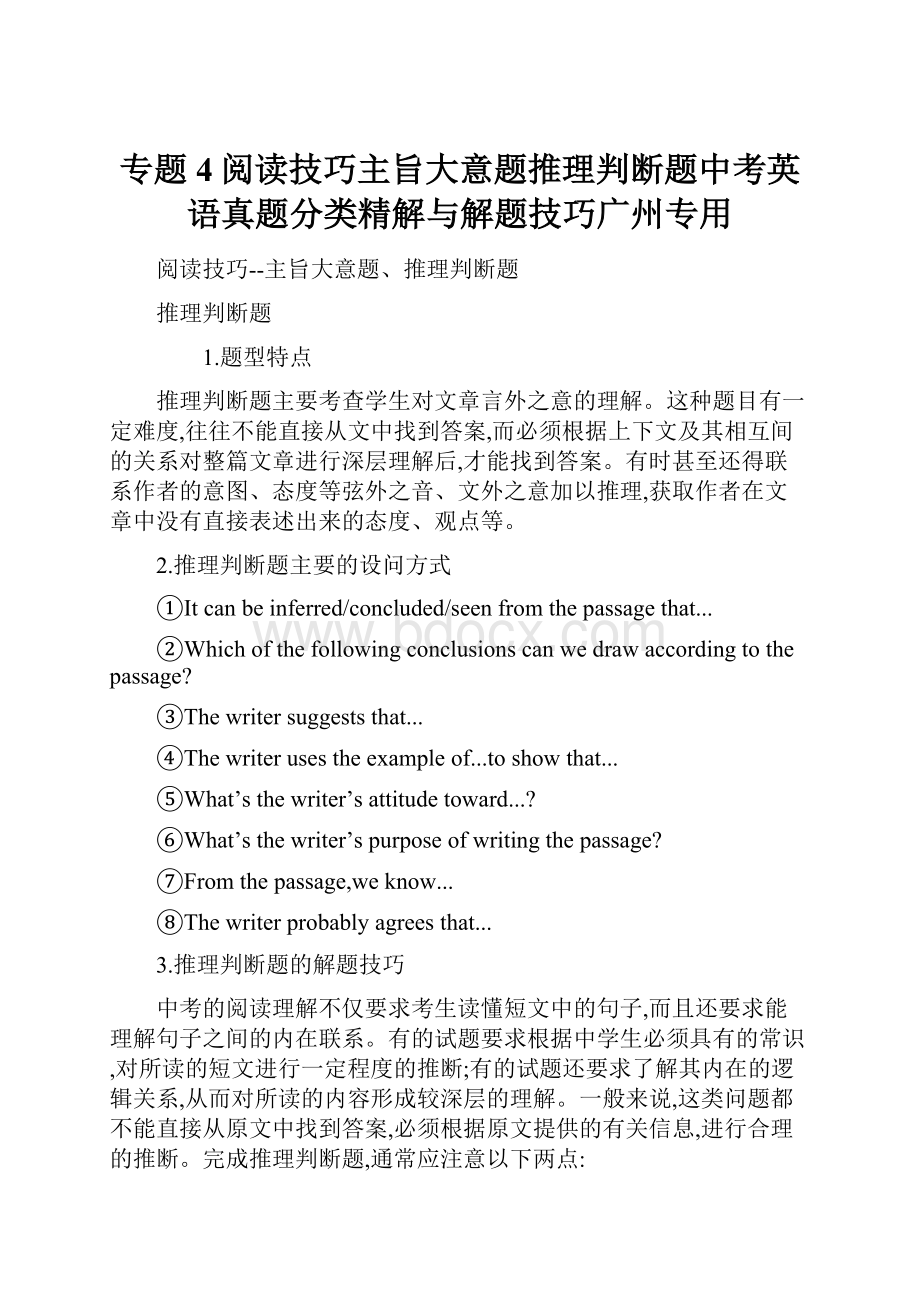专题4阅读技巧主旨大意题推理判断题中考英语真题分类精解与解题技巧广州专用.docx
《专题4阅读技巧主旨大意题推理判断题中考英语真题分类精解与解题技巧广州专用.docx》由会员分享,可在线阅读,更多相关《专题4阅读技巧主旨大意题推理判断题中考英语真题分类精解与解题技巧广州专用.docx(39页珍藏版)》请在冰豆网上搜索。

专题4阅读技巧主旨大意题推理判断题中考英语真题分类精解与解题技巧广州专用
阅读技巧--主旨大意题、推理判断题
推理判断题
1.题型特点
推理判断题主要考查学生对文章言外之意的理解。
这种题目有一定难度,往往不能直接从文中找到答案,而必须根据上下文及其相互间的关系对整篇文章进行深层理解后,才能找到答案。
有时甚至还得联系作者的意图、态度等弦外之音、文外之意加以推理,获取作者在文章中没有直接表述出来的态度、观点等。
2.推理判断题主要的设问方式
①Itcanbeinferred/concluded/seenfromthepassagethat...
②Whichofthefollowingconclusionscanwedrawaccordingtothepassage?
③Thewritersuggeststhat...
④Thewriterusestheexampleof...toshowthat...
⑤What’sthewriter’sattitudetoward...?
⑥What’sthewriter’spurposeofwritingthepassage?
⑦Fromthepassage,weknow...
⑧Thewriterprobablyagreesthat...
3.推理判断题的解题技巧
中考的阅读理解不仅要求考生读懂短文中的句子,而且还要求能理解句子之间的内在联系。
有的试题要求根据中学生必须具有的常识,对所读的短文进行一定程度的推断;有的试题还要求了解其内在的逻辑关系,从而对所读的内容形成较深层的理解。
一般来说,这类问题都不能直接从原文中找到答案,必须根据原文提供的有关信息,进行合理的推断。
完成推理判断题,通常应注意以下两点:
(1)特别留心特定细节
所谓“特定细节”,就是问题所涉及的范围和对象中的细节事实。
它一般包括事实根据、名字(人物或地点)、数字(日期或统计数字)、关键词语的其他表达方法(同义词、近义词、反义词)等。
(2)注意作者的语气和态度
作者的语气和态度通常体现在短文所使用的措辞和句式上。
要特别注意感情色彩比较浓重的形容词和副词,特别留心短文句子的长度和结构。
从措辞上我们可以推断出作者对所讨论话题的态度;从句式的长短和结构可以判断出作者讨论问题的语气。
一
2020广州中考
Howwouldyouliketobuildatimemachine?
Paper,sticks,glueandstringareallyouneed.Putthemtogethertobuildakite.Akiteconnectsyoutothepast.
Nooneknowswhoflewthefirstkite.ItwasprobablysomeoneinChinaorperhapsIndonesia.Indonesia.Indonesianfishermenhungfishhooksonkitesandsentthemouttoseatocatchfish.Starting2,000yearsago,ChinesefarmersflewkitestowelcometheNewYearandbringgoodlucktoEarth.
InChina,peoplealsousedkitesduringwartime.OneChinesestorytellshowsoldiersputnoisemakersonkitesandflewthematnightovertheenemycamp.Theenemieswerefrightenedbythenoiseandranaway.
About1,300yearsago,ChinesetravelerstookkitestoJapan.Soonkitesfilledtheskiesthere.KitesreachedThailandabout700yearsago.Duringfloods,ThaifarmersflewkitesovertheirfieldsTheyhopedthekiteswoulddriveawaythecloudsandstoptherain.Overtime,kitesflewtheirwayoutofAsia.Today,kitesareapassionallovertheworld.Kitefansmeetatfestivalsinmanypartsoftheworldandhavegreatfun.
Overtheyears,Kiteshavealsohelpedpeopleunderstandthenaturalworld.In1749,forexample,thermometersweretiedtokitestomeasuretemperatures.In1906,camerashangingfromkitestookpicturesofSanFrancisco,Californiaafteranearthquake.Thephotoshelpedpeopleplanwhattodo.
Kitesalsohelpedinventorsfindouthowtomakeairplanes.TheWrightbrothersstudiedhowkitesflew,whichhelpedthemmakethefirstsuccessfulairplane.
SincetheancientChinesefirstsettheirkitesintotheair,peoplehavelovedflyingkites.Kitesgiveuswaystocelebrate,relaxandexplore.Sogoflyakite!
Enjoythefeelingofwonderthatkiteflyershavefeltforcenturies.
31.Accordingtothepassage,inwhichcountrieswerekitesusedtomakegoodwishes?
A.ChinaandJapan.B.ChinaandThailand.
C.JapanandIndonesia.D.ThailandandIndonesia.
32.AccordingtotheChinesestory,thearmyusedkitesto___________.
A.maketheenemiesleaveinfearB.celebratevictoriesduringwartime
C.stoptheenemiesfromsleepingwellD.carrysoldierstofightagainsttheenemies
33.Theunderlinedword“passion”inParagraph4means__________.
A.strongloveB.usefulmachine
C.happydreamD.commontreasure
34.HowdoesthewriterdevelopParagraph5?
A.Bytellingstories.B.Bylistingnumbers.
C.Bycomparingfacts.D.Bygivingexamples.
35.What’sthepurposeofthispassage?
A.Toshowpeoplehowtoflykites.
B.Toexplainhowkitesareusedinscience.
C.Tointroducetherolesofkitesinhistory.
D.Todiscussthedifferenceamongkitesworldwide.
二
2020广州中考
Whatwillastronauts(宇航员)eatwhenaspacetriptakesyears?
“Lotsoffreshvegetables,”saysDr.JanetWilliams,whoseteamhavespentthelast10yearslearninghowtogrowplantsinaspacestation.Andit’sagoodthingthatshehasalreadystartedherwork,becausespacegardeningcanbereallyhard.
Asusual,astronautGeorgeWhitelookedintotheclosedplantroom.HehadplantedDr.Williams’squick-growingseedlingsinit,butnoneofthestemswereshowing.Heopenedtheroomtocheckandfoundtheproblem.Thestemsweren’tgrowingupwardandtherootsweren'tgrowingdownward.OnEarth,gravity(重力)helpsaplant’sstemsandrootstofind“up”and“down”.However,inthespacestation,therewasalmostnogravity.
Dr.Williamssuggestedasolution:
givetheplantsmorelight,asplantsalsousesunlighttofindtheirway.Anditworked.Whentheplantshadmorelight,thestemsturnedupandtherootswentdown.
NowDr.Williamswasfreetoworryaboutthenextproblem:
Wouldherbabyplantslivetoflower?
Canwegrowfoodonaspacejourney?
Manyplantsdiedinthespacestation.Dr.Williamsthoughtsheknewwhy:
thespaceplantswerehungryforair.PlantslivebytakingupCO2fromtheair.Sinceaplantusesitupintheairaround,theplantneedsmovingairtobringmoreCO2closetoitssurface!
OnEarth,theairisalwaysmoving.Gravitypullsdowncoldair,andwarmairrises.Andwiththeseairmovements,plantsgetenoughCO2.
Manyearlierexperimentswithplantsinspacehadusedclosedrooms.Dr.Williamstriedanewgreenhousethathadafantokeeptheairmove.Theplantslovedit.Theyfloweredandevenproducedmoreseeds.UsingDr.Williams'smethod,astronautGeorgecompletedthefirstseed-to-seedexperimentinspace,andmovedoneplantclosertoagardeninspace.
“Andthis,”saysDr.Williams,“isgoodnewsforlong-termspacetravel.”
41.WhyhaveDr.Williams’steamtriedtogrowplantsinspace?
A.Toproducefreshairforastronauts.
B.Tohelpastronautsrelaxthemselves.
C.Toprovidefoodforlongspacejourneys.
D.Tomakethespacegardenmorebeautiful.
42.HowdidlighthelpsolvetheproblemmentionedinParagraph3?
A.Itcausedthegravitytochange.
B.Itencouragedtheplantstogrowfaster.
C.Ithelpedtheplantstogrowintherightdirection.
D.Itshowedtheastronautswheretoplantvegetables.
43.Whydidmanyplantsdieinthespacestation?
A.Thelightwastoostrong.
B.TherewastoomuchCO2.
C.Therewasnotenoughroomtogrow.
D.Theairconditionwasnotgoodenough.
44.Theunderlinedword“it”inParagraph7refersto________.
A.themovingairB.theclosedroomC.thespacejourneyD.thespacegarden
45.WhatcanwelearnaboutDr.Williams’steamfromthepassage?
A.Theymainlyliveonfreshvegetables.
B.Theyhavesuccessfullybuiltaspacegarden.
C.Theyinventedaspecialfanfortheirgreenhouse.
D.Theyhaveworkedonspacegardeningformanyyears.
主旨大意题
1.题型特点
要求在阅读和理解全文的基础上对文章进行归纳、概括或评价。
解答这种题型时,不能只凭文中的只言片语而断章取义,比如涉及文章的标题(title)、主题(mainidea)、结论(conclusion)、结局(end)等有关问题,都需要在细读全文的基础上,结合所学语言知识、背景知识、生活常识等进行逻辑推理和判断,从而获取文章中隐藏的信息。
2.主旨大意题主要的设问方式
①What’sthemainideaofthispassage?
②Whatdoesthepassagemainlytellus?
③Whatdoesthepassagemainlydiscuss?
④Thewritermeanstotellusthat .
⑤Themainideaofthepassageisthat .
⑥Thepassageismainlyabout .
⑦Fromthepassagewecanlearn/concludethat .
⑧Thelastparagraphischieflyconcernedwith .
⑨What’sthebesttitleforthepassage?
⑩Whatwouldbethebesttitleforthepassage?
Thebesttitleforthepassageis .
3.主旨大意题的解题技巧
(1)留心关键词,抓住文章主旨;串联主要细节,推断文章中心思想。
所谓关键词,即文章中反复出现的、与主题有关的诸如名词、动词等,冠词或介词等词均不在关键词之列。
需要注意的是,为了避免同一词的过多重复,文章有时会使用这个词的同义词、近义词或代词指代。
我们知道,并不是所有文章都包含明确的主题句,比如大多数的记叙文。
记叙文的中心思想多隐藏在具体的细节中,作者通过众多的细节事实对一个中心点进行论述。
因此,我们必须善于串联主要细节,从中归纳文章的中心思想。
(2)注意段落主题句,归纳文章大意。
段落的主题通常由被称为主题句的句子来表示。
主题句有两个功能:
①介绍段落的主题;②阐述控制概念,控制概念用以控制段落中句子讨论的内容。
主题句通常是一段的第一句或末尾一句,偶尔在一段中间。
我们在阅读非故事性文章如科普文章的时候,主题句尤为明显。
有的文章无明显的主题句,主题句隐含在段意之中。
①主题句位于段首
主题句位于段首是由作者先立论点,后摆事实讲道理的写作手法形成的。
这种段落称作演绎型段落。
据有关统计数字表明,在英语议论文或说明文中,有60%~90%的主题句是段落的第一句。
a.寻找主题句
有些段落有明显的引出细节的信息词,常见的信息词有:
forexample,anexampleof,themostimportantexample,first,second,next,then,last,finally,tobeginwith,also,besidesthat等。
在阅读中,应尽量利用上述信息词确定主题句的位置。
如果无明显的信息词,可先假设第一句为主题句,在第二句前面添加一个forexample,看看第二句是否可以支撑第一句话,如果第二句不能支撑第一句话,便在其他地方找出主题句。
b.选择答案
先彻底弄懂主题句的句意,然后阅读所给的选项,选择与主题句句意相吻合的答案,如主题句的再现,主题句句意的复述或推论等,排除与主题句句意无关的答案,如支撑细节和文章中未曾阐述的事实等。
②主题句位于段末
主题句位于段末是作者采用了先摆事实,后做结论的手法。
这种段落称作归纳型段落。
③主题句位于段落的中间
主题句偶尔也出现在段落的中间,但不一定就在正中间。
有时,第一句并非主题句,而是承上启下的过渡句。
在这种情况下,第二句便成了主题句。
此外,主题句也可能是段落的倒数第二句。
一
2017广州中考
Peoplecan’tseeyouwhenyou’respeakingonthephone,buttheycanhearyou.So,thewayyouspeakisespeciallyimportant.Infact,researchershavecalculatedthat80%ofcommunicationoverthephoneisthroughyourtoneofvoice;andonly20%isfromthewordsyouuse.Hereareourtoptipsonhowtospeakoverthephone.
1.FacialExpressions
Yourfacialexpressioncaninfluenceyourvoice.Forexample,ifyousmile,yourvoicewillsoundwarmandfriendly,justtheopposite,ifyouhaveanangrylookonyourface,itcanmakeyousoundunpleasant.
2.Volume
Ifyouspeaktooloudly,youcouldsoundangry.Andifyouspeaktoosoftly,it’llbedifficulttohearyou.So,speakloudlyenoughtobeheardclearly,butnotsoloudthatyou’reshouting.
3.Pace
Thepaceofyourvoiceishowquicklyyouspeak.Andthiscanshowhowyoufeel.Forexample,anangrypersonmightspeakfasterthannormal.Oradownheartedpersonmightspeakveryslowly.Tryspeakingalittlemoreslowlythannormal.Thiswillmakeyousoundconfident,andit’llmakeiteasierfortheotherpersontounderstandyou.
4.Gestures
Gesturingcaninfluencethetoneofyourvoice.Whenyougesture,youbringmoreairintothelungs,whichcanmakeyourvoicesoundwarmer.Gesturesarealsousefultohelpyoustresstherightwordsorevenfindthewordsyouneed.Thebestthingaboutgesturingduringaphonecallisthatnoonecanseewhatyou’redoing,soyoucangestureaswildlyasyoulike!
5.Movement
Ifyou’